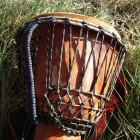Last weekend I had the opportunity to play in two drum groups for a young friend’s going-away party at a community hall. Our fledgling West African drumming practice group got invited to kick off the festivities, followed later by the established batucada group, Samba du Soleil. The former group consisted of three dundun players and me on djembe, while the samba group had nine members playing a full complement of Brazilian instruments, and a well-rehearsed arrangement of five pieces.
 The first set was hampered by our sangban player missing from sickness, replaced on the spot by a talented transplant from the samba group. It was going to be informal anyway, layering in part by part until the dun parts meshed, then adding in traditional and original djembe solos.
The first set was hampered by our sangban player missing from sickness, replaced on the spot by a talented transplant from the samba group. It was going to be informal anyway, layering in part by part until the dun parts meshed, then adding in traditional and original djembe solos.
After Soko, I said to the crowd of twenty-some twenty-somethings, who had been merrily gyring around the floor, that our music was “not intended to be a flashy performance, but just to groove… which you’ve been doing anyway, so, let’s keep doing that.”
What I should have said, would be to introduce the music and say we were a practice group, joined by a sangban player who was taking on these rhythms for the first time. Layering in worked well to establish the groove, but then I went right into the sequence of traditional solos, as if there were some invisible West African dance class in the room instead of the gyring hippies who just wanted to flow and connect with the music.
Some of the solos went smoothly, some a little rough, and I relished as always the tapestry of variations, largely from my overdriving mental catalogue of schematic notation, with maybe ten percent of free soloing, usually riffing off fragments or mistakes from the traditional solo phrases.
What I should have done was to honor my intention to connect with and play from the groove, to the audience in that room, from the heart of the music rather than from my extensive ethnographic program. I realized this oversight in my bodily sense while walking, the next day, each step marking the cadence with the beats still tracking in my brain and infusing the blood… Coming from that place of organic motion, those fragments could spring more organically from the music, connecting also with the vibe of the dancers.
Learning from the experience, I could use these tools in future to enhance local community, rather than to project as if on a screen the flavors of an imported culture. Likewise, in preparation for such an event, it could be more productive to visualize a holistic experience with the audience and the venue, instead of simply practicing and memorizing the notation and handing of the rhythms themselves.
Bottom line, it’s not about the rhythms for their own sake, but about the interactive experience that the rhythms are tools for unlocking. And even just in terms of the music itself, the point is not to try to recreate “traditional” solos faithfully (ultimately an impossible task, especially for a person not of that tradition), but rather to use them as guideposts to the territory, leading to and from the heart of the music: the pulse and the texture created by the duns.
In addition, we had a shaker and percussion player from the samba band standing by trying more or less successfully to follow and fit in, along with a stray djembe volunteer from the audience. Instead of making an effort to help them follow the pulse and engage them in the group, I largely ignored them because they were late additions to the mix and I was, again, too fixated on my own program of solo sequencing.

Thankfully, the samba performance later was more satisfying. Though I was entrusted with leading the arrangements, my own part as a timbau player was integral more than prominent, even when I carried off competently a sixteen-bar set solo during Samba Reggae. The overall mix was balanced and dynamic, feeding and feeding off the room’s enthusiastic dance energy.
So, the point of this exercise isn’t to tear myself down or build myself up, but just to share some useful debriefing of how things can go during performance, and how they might improve.
I hope you find this mini-lesson helpful for your next show!
 For more tips, lessons, and rhythms for West African and Brazilian drumming, see Roots Jam 4: World Beats.
For more tips, lessons, and rhythms for West African and Brazilian drumming, see Roots Jam 4: World Beats.

